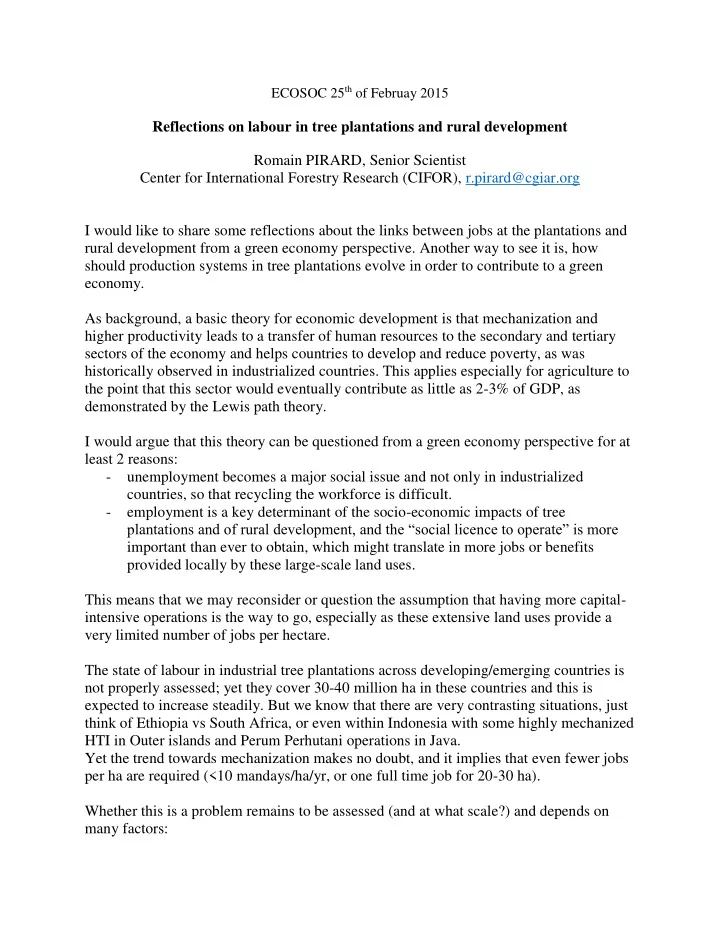

ECOSOC 25 th of Februay 2015 Reflections on labour in tree plantations and rural development Romain PIRARD, Senior Scientist Center for International Forestry Research (CIFOR), r.pirard@cgiar.org I would like to share some reflections about the links between jobs at the plantations and rural development from a green economy perspective. Another way to see it is, how should production systems in tree plantations evolve in order to contribute to a green economy. As background, a basic theory for economic development is that mechanization and higher productivity leads to a transfer of human resources to the secondary and tertiary sectors of the economy and helps countries to develop and reduce poverty, as was historically observed in industrialized countries. This applies especially for agriculture to the point that this sector would eventually contribute as little as 2-3% of GDP, as demonstrated by the Lewis path theory. I would argue that this theory can be questioned from a green economy perspective for at least 2 reasons: - unemployment becomes a major social issue and not only in industrialized countries, so that recycling the workforce is difficult. - employment is a key determinant of the socio-economic impacts of tree plantations and of rural development, and the “social licence to operate” is more important than ever to obtain, which might translate in more jobs or benefits provided locally by these large-scale land uses. This means that we may reconsider or question the assumption that having more capital- intensive operations is the way to go, especially as these extensive land uses provide a very limited number of jobs per hectare. The state of labour in industrial tree plantations across developing/emerging countries is not properly assessed; yet they cover 30-40 million ha in these countries and this is expected to increase steadily. But we know that there are very contrasting situations, just think of Ethiopia vs South Africa, or even within Indonesia with some highly mechanized HTI in Outer islands and Perum Perhutani operations in Java. Yet the trend towards mechanization makes no doubt, and it implies that even fewer jobs per ha are required (<10 mandays/ha/yr, or one full time job for 20-30 ha). Whether this is a problem remains to be assessed (and at what scale?) and depends on many factors:
- How are additional profits used ? Greater mechanization might generate more value for reinvestment nationally or regionally/locally, e.g. through tax collection and public spending, or benefit-sharing and local development programs as we see in Indo nesia (PMDH, LMDH…). But it is doubtful that all additional profits will translate into new jobs in other sectors, especially in a context of a declining labour share of income (with more for capital) since the 1980’s. - Quality of jobs . Almost all jobs are on daily basis without contracts and associated benefits and social security. In this context these jobs might poorly contribute to a sustainable development, and may not be very appealing to people (even if they remain filled in a context of poverty and lack of formal employment opportunities). - Desirability of more labour-intensive operations . There are reasons for enhanced mechanization beyond productivity and financial returns: young people lack interest and want to work at factories, people are less controllable and less predictable than machines and associated transaction costs, notion of progress and path dependency, existing incentives (e.g. energy subsidies) or dis-incentives (constraining regulations on the labour market), shortage of labour in some areas, etc. - Flexibility at the plantation to accommodate other economic activities. People usually see jobs at the plantation as complementary to other core land uses such as agriculture, so that the capacity to provide flexibility for work at the plantation might be key to attract workers. - Densities of population and level of local development. - Establishment of outgrower schemes that might improve the distribution of benefits. - Sub-contracting . Evolution of the role of sub-contracting and impacts on the work conditions. Case of South Africa: good when policies to encourage local entrepreneurship with black people, but adverse impacts when more difficult for workers to organize among themselves with trade-unions. If one considers the problem of labour in industrial tree plantations from a green economy perspective, other fundamental issues merit our attention: - Is rural development a priority? And if so, is it better to increase the capital- intensity of operations in order to increase investments in other sectors based on the additional profits. Or is it better to maintain / increase employment at plantations at least until rural areas are more developed and provide alternative opportunities. - Is it possible to change production systems in order to create more and better jobs related to new tasks? Agro-ecology might provide a source of inspiration (e.g. ecological intensification, knowledge- based systems…), all the more so as tree plantations have a great potential to provide many ES if properly managed (e.g. HCVF, multi- species plantations…).
- Anticipating on future energy prices and social costs to compare capital- intensive and labour-intensive systems: GHG emissions, other pollutions, dependence on imported heavy machinery…). - Rural-urban migrations and their impacts on poverty as more people live in fast- growing cities and often in difficult conditions
Recommend
More recommend